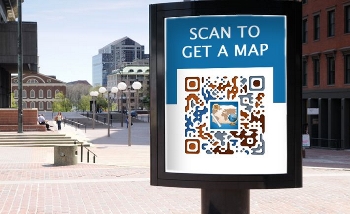Matrix Barcode vs QR Code
QR or Quick Response Codes are being used more and more, and if you haven’t spotted one recently you’ve probably been living in a cave! But what exactly makes a QR code different when compared to any other type of Data Matrix code? Here, we look at those differences.
What Is A Data Matrix Code?
Data Matrix codes are basically 2D (two-dimensional) codes which are made up of white and black modules that have been typically arranged across a square-shaped pattern. When extra data needs to be encoded, the number of modules (or columns and rows) has to increase.

A complete Data Matrix symbol is capable of storing as many as 2335 alpha-numeric characters. This data identifies the details of the specific component that it has been placed on, including the part number, unique serial number and manufacturer’s ID.
When it comes to Data Matrix codes, their most common application is in marking small items. This is because it can encode a vast amount of information within only a minimal space. The DoD (U.S. Department of Defence) currently requires Data Matrix Codes to be used for UID (Unique Item Identification) for certain assets like weapons as well as major systems’ critical components. Each asset has to be marked using its own unique Data Matrix Code as per the Military Standard 130 rules. The DoD isn’t the only organisation which is using Data Matrix Codes to mark and identify items. Many companies within the Aerospace Industry also use Data Matrix codes, particularly those which are members of the ATA (Air Transport Association) which aim to identify every component that goes into making new aircraft with a Data Matrix code.
What Is A QR Code?
QR codes are a different form of 2-dimensional code which is made up of only black modules which have been arranged on a white-coloured background in a square-shaped pattern. The information which is encoded can consist of any form of data, either alpha-numeric or binary which makes the QR code a more versatile and flexible choice.

QR codes were originally designed back in the 1990s for use within the automotive industry for tracking vehicles as they went through the process of manufacturing. In recent times, however, QR codes have been increasingly used for commercial purposes like marketing and entertainment, targeting users of smartphones. They are being harnessed more and more for use by marketing specialists as a way of engaging consumers and interacting with them in an exciting way to encourage them to remember the brand that they are advertising and access their website.
QR codes which store web addresses now frequently appear on signs, in magazines, on business cards and on printed adverts allowing users who have a downloaded barcode scanner app on their smartphone to simply scan the QR code and view the contact information, text or web page connected to the barcode using their device’s browser.
While QR codes aren’t usually used for standard data capture applications, they are often useful if the software program isn’t available using a scanner but is reachable via a website. When the user scans the QR code using their device, the data will be transferred immediately to the website where it is entered.
When Are Data Matrix Codes the Right Choice?
When it comes to asset identification or tracking, or other data-driven applications, the best choice tends to be a traditional Data Matrix code. While they are generally small, Data Matrix codes are capable of storing vast amounts of information for encoding, and this makes them ideal for use across a broad spectrum of applications.
Check out how the QR code compares to the 1D Code.
Use Now
2025 (c) QR Me, All Rights Reserved Terms and Conditions | Privacy